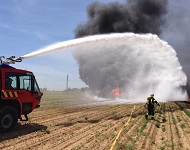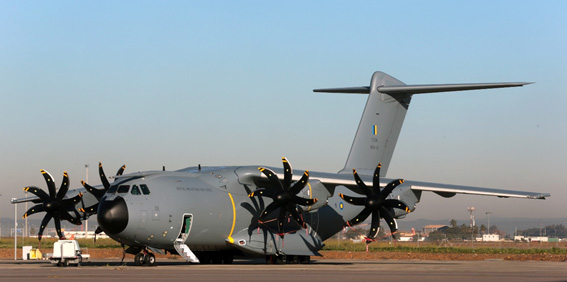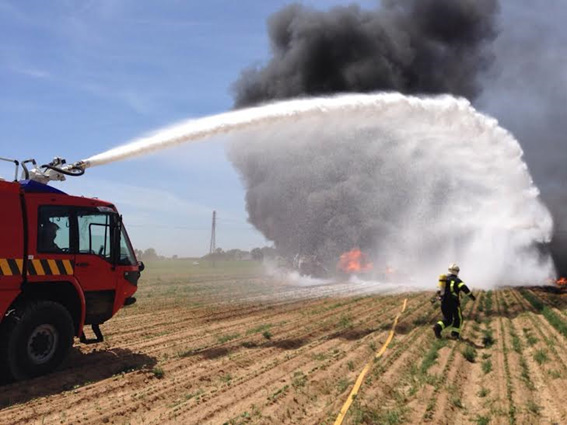
By George H. Potter
The Airbus Defense & Space Company is a consortium that manufactures military aircraft. It is a branch of Airbus Industries, the European multinational aircraft industry that designs and builds an extensive range of civil aviation, passenger, and cargo aircraft (more than 15 models); executive aircraft; and military aircraft including the Eurofighter, the A330MRTT (Multi-Role Tanker Transport), and the A400M ATLAS, which is claimed to be the world’s most versatile airlifter, capable of cargo, troop, mixed, and heavy material transport and air-to-air refueling, offering the unique capability of short takeoff and being able to land on nearly any surface. Since its inception in 2003, and in response to seven European countries needing a highly versatile, multifunction aircraft, 184 airplanes were ordered. The first flight of an A400M was in 2009; a significant number of units have been delivered.

(1) The AIRBUS A400M is the largest propeller-driven cargo aircraft currently in operation. (Photo courtesy of Airbus Industries.)
The components of the A400M are manufactured in seven different countries: France, Germany, Spain, UK, Belgium, Turkey, and South Africa. The Spanish affiliate of Airbus is responsible for the overall management of the project as well as the final assembly of the airplanes and their flight testing.
Shortly after midday on May 9th, 2015, an A400M destined for the Turkish Air Force took off from the airport of Seville, Spain, for its maiden test flight. On board were six Airbus technicians including the four-member flight crew. A few minutes after takeoff, the pilot informed the Seville Airport air traffic control that the plane had experienced an undisclosed mechanical failure and requested permission to land; that request was immediately approved. The aircraft circled back to approach the airfield and descended. Just 1½ miles from the airport, the aircraft struck a high-tension power line pylon, which caused the plane to crash in a farm field. The flight crew and one other technician perished in the crash, while the two other employees suffered grave but nonfatal injuries.
Two parallel investigations were initiated: an official investigation by the Spanish Ministry of Defense and an unofficial technical investigation by Airbus. Several countries that are using A400M aircraft ordered temporary grounding of their planes until results of the investigations come to light. Some initial suspicions indicate the possibility of problems in the software of the electronic control units (ECUs) installed in each motor. Both of the black box flight recorders were sent to the United States for analysis. Other possible causes cannot be discarded. Several days after the crash, it was reported that the aircraft experienced significant power losses in three motors, confirming the theories of the problems in the ECUs.
As the aircraft crashed outside the airport facility, the initial emergency response was the responsibility of the Seville Provincial Fire Service (SPFS). This agency is composed of 26 stations, seven of which are manned by 277 full-time professional firefighters and officers, while the remaining 17 stations are covered by approximately 270 volunteers. The Seville Municipal Fire & Rescue (SMFR) Brigade boasts 450 firefighters and officers operating out of four stations; this service also responded to the crash. The Seville Airport Crash & Rescue (SACR) service has 31 firefighters manning three heavy crash tenders out of one station. This airport has an International Civil Aviation Organization emergency response level of 7 on a scale of 1 to 9. The Spanish civil aviation authority, AENA, “recommends” that airport fire services should not respond to incidents outside of the airports’ premises. The Airbus facility has a small, industrial-type emergency response team with one engine.
INCIDENT EVOLUTION
On receipt of the communication from the A400M, the airport control tower alerted the airport’s Crash & Rescue Service, mobilizing the three crash tenders, each manned by three persons: a crew chief, the driver/operator, and one firefighter. These vehicles were dispatched to their assigned positions near the runway according to protocols in anticipation of an emergency landing.
13:00. The A400M descends to make an emergency approach to the airport. The descent was very pronounced, and the aircraft was so close to the ground that it hit a high-tension electric power line pylon, which brought the plane to the ground almost instantly.
The airport control tower informs the Crash & Rescue teams that the aircraft has crashed outside the airport.
The emergency call center of Andalucia—112 (ECCA)—receives several calls from the area around the airport informing of the crash. The ECCA alerts the closest provincial fire station in Alcalá de Guadaíra, approximately 10 miles south of the airport and the SMFR service. Both agencies dispatch vehicles and personnel.
An engine from Alcalá de Guadaíra arrives on the accident scene with a crew of three, closely followed by one crash truck and two engines from SMFR as well as various police cars. Almost immediately, another airport crash truck arrived.

(2) An airport crash truck applies foam onto the wreckage while the Seville, Spain, firefighters extinguish the small ground level fires around the crash. Almost nothing remained of the aircraft principally because of the high content of composite materials used in its construction. (Photo by C. Dominguez, SPFS.)
Within 20 minutes, three SACR crash trucks, two SMFR provincial engines, two SMFR engines, an Airbus emergency response team engine, and one ambulance were on scene with around 20 firefighters and at least two emergency medical technicians. At this time, there was no clear command structure in place.
The Seville Airport management ordered the airport closed to air traffic as the entire crash and rescue unit was at the crash site. The airport crash tenders discharged their foam loads onto the wreckage and promptly returned to the airport, leaving the incident in the hands of the public fire services.
The bodies of the four dead aircrew as well as the two survivors were removed from the wreckage. The two seriously burned survivors were transported to hospitals in Seville for treatment. Two weeks after the incident, these two were still in very serious although stable conditions.
Less than half an hour after the crash, the airport was reopened for air traffic, as the SACR service had returned to the facility and recharged water and foam concentrate. Investigators from the national police corps and AIRBUS arrived on the scene to begin parallel investigations into the cause or causes of the crash.
POSTINCIDENT CONSIDERATIONS
During the years preceding this incident, several joint exercises had been held with the airport emergency services and the provincial fire services. SMFR service was never invited to participate in these exercises; all of these exercise were held simulating incidents involving aircraft within the airport’s perimeter, and none outside the airfield.
Effective incident management is a notorious weakness in the Spanish emergency services, with the exception of a few of the major municipal and provincial agencies. Reports of serious miscommunication between civil and airport fire services and the various police agencies on scene in this particular incident came from several sources. There was some comparison between this incident and the train derailment nearly two years ago in Santiago de Compostela in the Northwestern region of Galicia in regards to the lack of a clearly defined incident command structure.
There is a very apparent need for training in the Spanish fire services. Again, the really large services do maintain ongoing training, often involving joint exercises with other agencies responsible for specific hazards such as aviation, railways, tunnels, ports, and similar hazards, but the smaller, more rural-oriented services and those managed by private enterprises are seriously hampered by the lack of adequate instruction. Many smaller services even lack anyone qualified and responsible for organizing and supervising training programs.
This type of emergency requires extensive, closely interrelated coordination and cooperation among the varied response entities. In this particular incident, there were only four fatalities. The crash of Spainair MD82 at Madrid International Airport Barajas in 2008, killing 153, put the Madrid municipal and provincial fire and rescue services as well as the airport’s emergency services to the test, a test in which all agencies passed as a result of their continuous joint training exercises.
George H. Potter is a practicing fire protection specialist who has lived in Spain for the past 47 years. He served as an Anne Arundel County, Maryland, volunteer firefighter with the Riva Volunteer Fire Department and the Independent Hose Company in Annapolis and as an ambulance driver with the Wheaton (MD) Rescue Squad. He served six years in the United States Air Force as a firefighter, an apparatus driver/operator, and a crew chief. He has been involved in fire protection system installation, mobile fire apparatus design, and construction and fire safety training. He is a Spain-certified fire service instructor and a hazmat specialist, and is a member of the Board of Governors of the Spanish Firefighters‘ Association (ASELF).
MORE GEORGE H. POTTER
- Stress: The Silent Killer
- Ebola Crisis in Spain Demonstrates the Need for Professional Crisis Management
-
Mass Casualty Incident: Spanish Train Derailment, Part 2
- Mass Casualty Incident: Spanish Train Derailment, Part 1
- Five Women Crushed at Overcrowded Concert in Madrid, Spain
- Fire Commentary: European Firefighting Operations
- International Fire Safety Legislation: An Overview

